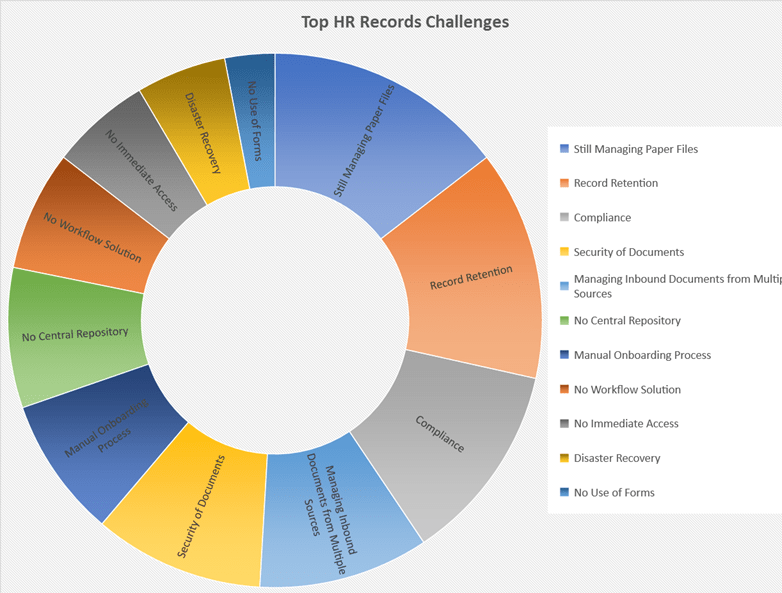
Back in 2017, we talked about HR record-keeping best practices at ADP Meeting of the Minds. From our talks with session attendees we discovered that while most handle employee records in their own ways, the top three challenges they faced remained consistent.
Today, this remains one of our most popular blog posts—and for good reason. Read on to learn about the challenges ADP users pointed out then that are still relevant in HR today.
1. Still managing paper files. It’s not surprising that paper documents are still found in HR. Many simply struggle to make paperless a priority in their department. Others are still concerned about the security of electronic records, the potential for a data breach or employees having access to data they shouldn’t see. But paper documents are much more susceptible to privacy and security risks. They’re also slow, error-prone and vulnerable to natural or man-made disasters.
HR departments are also struggling to manage documents coming in from multiple sources at different times. Documents are coming in through mail, fax, email, web forms and file downloads. They’re created and stored in various HR applications. Even for those who have converted most of their employee records to digital, they’re still receiving paper from one source or another, or they’re printing out electronic documents for signatures and filing purposes. Not only does this allow paper to persist but, it creates a hybrid paper and digital environment where employee records are spread across different systems and locations, making it impossible for HR to have a single view of any one employee.
Instead, HR departments should embrace the transition to paperless. They should scan their existing paper records into digital files and import them into a secure centralized repository where documents can be consolidated together all in one location. Then, import existing electronic records from network share drives and other HR systems such as onboarding, applicant tracking, performance review, and HCM systems.
The right solution should allow them to capture and collect documents from all of these sources as they come in. It should auto-categorize them for retention and user access, automate workflows and integrate documents and data with their existing HCM systems. And, it should include features such as audit trails and encryption at-transit and at-rest so documents remain protected from the time they are received or created and stored until they are accessed and shared.
2. Record retention. It’s amazing how many rules and regulations HR has to keep up with so of course, record retention continues to be a burden. They have to comply with federal and state laws and regulations specific to their industry. This regulatory environment has created retention rules that are based on each type of document. I-9 forms, FMLA records, benefit records and worker’s compensation claims all have different retention periods—from 2 to 30 years. Certain employee records must also be filed and maintained separately from the rest. How can any one person possibly manage this complexity and stay compliant?
An effective document management system helps by doing most of the work for you. As documents come in, the system automatically identifies and classifies each document into standard and custom categories. Based on the document type, the system delivers the document to the proper filing location or routes it through a workflow process. And, with each document categorized, it’s easy to apply proper retention rules, user access permissions, and acceptable use policies.
3. Compliance. To stay compliant, and avoid legal and regulatory issues, HR has to properly and consistently manage, store and retain employee records according to requirements. That means they must know:
- What documents do they have?
- What documents do they need to keep?
- How long do they need to keep them?
- Who should have access to them?
- Are documents stored in multiple locations?
- How protected are they from a breach?
Based on this, they need to determine what process or solution will make it easier to meet changing requirements and ensure that procedures are followed systematically.
If you’re looking for ways to simplify records management in HR, contact us. We’re here to free your team from administrative burdens so you can shift your resources to what matters most—your people. yet





